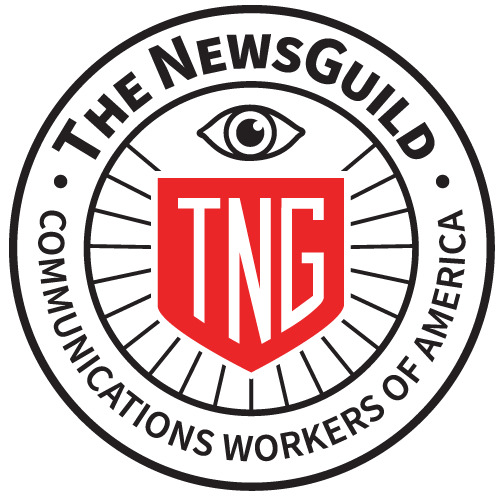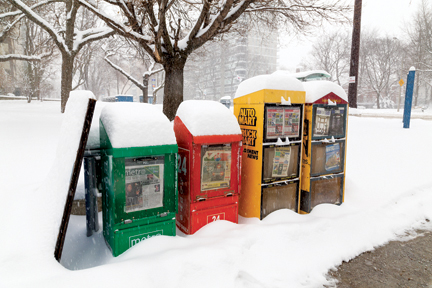By Julie Reynolds
Reporter-Editor, dfmworkers.org
For NewsGuild-CWA members at Digital First Media newspapers, the year began auspiciously. In January, a dozen units from the nation’s second-largest newspaper chain joined together in an unprecedented coalition to fight for long-sought wage increases and to launch a national #NewsMatters campaign to raise awareness about the importance of local journalism.
It’s a fight that continues as we enter a new year with nothing less than democracy at stake.
To inform and inspire as we continue our efforts, here’s a look back at some of journalism’s highlights and lowlights in 2016, plus a glance toward what 2017 promises.
Digital News Gets Organized
Last year began with a big “woo-hoo!” as the Huffington Post became the largest unionized digital news operation. But other news was bleaker. Al Jazeera America shut down, only months after members voted to join the Guild. Despite the setback, movements to organize digital news workers gained considerable momentum.
In April, editorial workers at Vice News ratified their first-ever contract with another union.
In June, some 200 workers at Vice Canada organized with the Canadian Media Guild.
Here’s a sobering factoid from media biz analyst Ken Doctor: “Facebook and Google suck up as much as 90 percent of all new digital ad revenue worldwide, and more than 60 percent in the U.S.”
By summer, the editorial staff at the LexisNexis-owned Law360 voted 109–9 to join the New York local. Law360 used a “union avoidance” firm, and employees were pulled into daily hour-long meetings with the consultants, LexisNexis executives, and senior Law360 managers. Five days before the election, the editor-in-chief and a managing editor were fired and escorted out of the building, a move many employees saw as a dramatic effort by management to show that it was ready to make changes if they rejected the Guild.
Also, staff at the longstanding — dare we say “staid?” — print and now digital magazine Foreign Affairs joined the Washington-Baltimore local with nary a fight from management.
As nearly all media companies race to expand their online presence in 2017, here’s a sobering factoid from media biz analyst Ken Doctor: “Facebook and Google suck up as much as 90 percent of all new digital ad revenue worldwide, and more than 60 percent in the U.S.”
Gulp.
Newspapers’ Wild Ride Continues
On the print side, the year opened with a shocker as Philadelphia’s papers suddenly went — no kidding — nonprofit.
In an insanely complex transaction, the owner of The Inquirer, the Philadelphia Daily News, and Philly.com donated the news organizations to a newly created media institute called The Philadelphia Foundation.
Philly Guild leaders had suggested such a move to the papers’ owners in 2013, but were given “zero warning” the move would actually happen, local president Howard Gensler said.
Four other papers in the greater Philadelphia area — the Pottstown Mercury, the Norristown Times-Herald, the Delaware County Times and the Trentonian — are owned by Digital First Media.
In January that group joined with Guild units at the Denver Post, the San Jose Mercury News, the East Bay Times, he Monterey Herald, the St. Paul Pioneer Press, the Macomb Daily and Daily Tribune, and the Kingston Freeman to announce the launch of the joint campaign to raise wages after some DFM workers hadn’t seen a pay increase for up to 10 years. The group launched social media pages — and this website — to kick off the campaign.
 In late spring, even as DFM management cried that strapped finances would continue to force layoffs and outsourcing, the company, owned by “vulture” hedge fund Alden Global Capital, managed to find $50 million under its sofa cushions to buy the Orange County Register and other Southern California papers. Of course, the purchase was immediately followed by layoffs.
In late spring, even as DFM management cried that strapped finances would continue to force layoffs and outsourcing, the company, owned by “vulture” hedge fund Alden Global Capital, managed to find $50 million under its sofa cushions to buy the Orange County Register and other Southern California papers. Of course, the purchase was immediately followed by layoffs.
On June 17, the DFM Workers coalition held a national day of action for the #NewsMatters campaign, gathering more than 10,000 signatures for a petition to Alden Global Capital, demanding full transparency about the hedge fund’s investments and investors, as well as its political donations.
NewsGuild president Bernie Lunzer said Alden “operates as a dark web of complex business structures to hide itself from public view.” With a touch of irony, Lunzer noted that the company has been “laying off the very journalists who’d be reporting this kind of vital information to the public.”
And lest we forget, Ken Doctor is there to remind us that “DFM and nearly all — perhaps all — of its papers are profitable.” When Alden unsuccessfully tried to sell DFM in 2014, its profits totaled an estimated $125 million a year.
By July, the #NewsMatters “Group of 12” made history, getting DFM to negotiate a joint 3-year contract for the entire dozen. The agreement included a 3-percent pay increase — a modest but significant win for those who’d suffered nearly a decade without. In August, the contract was ratified.
For DFM workers, 2017 brings a new wage re-opener for the Group of 12 and a chance to regain ground after increased health-care costs hit workers hard at 2016’s end.
Buying Binges, or, Hedge Funds Gone Wild
Making Florida history, two papers in the state went Guild after a large chain swooped in to buy them. In August, the Lakeland Ledger became the first Florida paper to unionize. Yes, the very first.
A month later, the Sarasota Herald-Tribune followed suit. The votes came a year after both papers were bought as part of an ongoing buying spree by GateHouse Media, another hedge-fund-owned chain that follows the ol’ slash-and-burn philosophy — staff cuts and wage freezes to bolster short-term dividends and profits.
As December blew in, workers at the Toledo Blade signed a new, one-year contract after two and a half years, gaining employee bonuses, a new compensation plan for ad sales staff, more vacation time, elimination of unpaid sick days, and a 401k match for employees for the first time.
Like DFM and GateHouse, another newspaper chain, Gannett, has been on a buying binge, despite claims that falling revenue forces — simply forces — the company to cut staff and halt wage increases. After buying the Bergen (N.J.) Ledger, Gannett announced in September it would lay off more than 200 workers as part of its “bold, ambitious vision.”
Yikes! Looking North in 2017
Meanwhile, larger papers are getting creative with their marketing in hopes of increasing readership. The New York Times is getting crazy ambitious about its online revenue, hoping to double it by 2020 and build online readership to 10 million. That’s up from less than 1.5 million now.
In an era when the new administration’s commitment to transparency is, well, opaque, that shrinking American newsroom is needed more than ever.
Despite the complaints of an election year in which nearly everyone griped about the press, the Trump era has led to subscription increases at some publications, including the Times, the Washington Post and Vanity Fair. In an era when the new administration’s commitment to transparency is, well, opaque, that shrinking American newsroom is needed more than ever.
Postmedia Network, a Toronto-based news chain that answers to the Manhattan-based hedge fund Golden Tree Asset Management (see a pattern here?), recently reported nearly $100 million in losses and is expected to go belly-up soon.
This and the worldwide newsroom shrinkage have inspired some in the government to take action. This year will start off with a government report on the future of the news media after the Trudeau administration held a series of public policy sessions in 2016. The government is already considering loosening tax codes to allow right-offs for charitable contributions to news media, and a federal fund is going to invest in digital media startups. Expect more ideas to come.
On a modest scale, here’s hoping 2017 will report surges in full-time online news employment and that newsroom organizing efforts continue.
And, perhaps most importantly, here’s hoping that civic-minded local newspaper buyers will emerge, owners who understand there’s so much more at stake than a hedge fund’s quarterly earnings.

